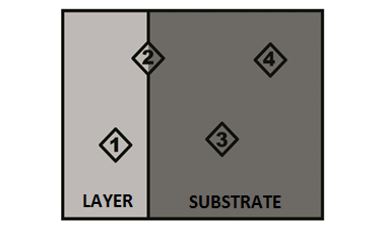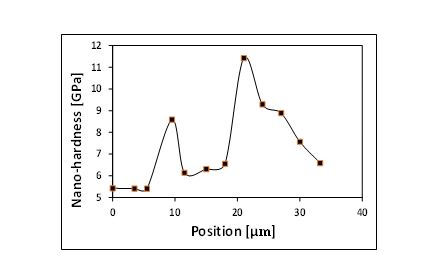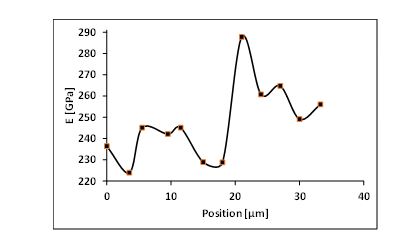1. Introduction
The industrial growth has generated the research of alternative process, as well as new tools and materials, due to the market faces to changing requirements. The industry uses coatings to protect materials used in machinery construction and devises, extending their service life and reducing maintenance cost and production. The main objective of coatings is give extra properties to materials, which improve their chemical and mechanical characteristics, such as hardness, thermal protection, wear resistance and corrosion resistance, among others. Therefore, to know the mechanical properties of protectives coatings has become an essential part to materials characterization, in order to develop in many way the substrate 1,2,3.
The ability of endure corrosion is attributed to the formation of dense oxide chromium layer formation and its slow growth. However, the water vapor in the air or oxygen can have a not good effect in the stainless steels oxidation inducing it to the catastrophic oxidation, due to the formation of not-protective oxide layer rich in iron, reducing the performance and service life of iron. The oxidation by water vapor has highly importance in materials selection for electric energy generation by vapor turbines, since in thermal plants many components are exposed to the water vapor at high temperature 4,5,6.
The advantages of chemical vapor deposition technique by fluidized bed are in the combination of the thermal activation and fluidized bed, which has as result the increase of the heat and mass transfer among the fluidized bed, gas and samples, obtaining a great stability of the temperature and a homogenous mix of reactive gases and the fluidized particles; generating a high quality reaction in the bed. The foregoing phenomenon implies to have a surface treatment combining the adaptability with low operative costs 5,6,7.
The study of mechanical, physical, chemical and structural properties are some of main characteristics for carry out the correct mechanical characterization of any material. At present, one topic of great interest about materials characterization is the relationship between the material structure and its properties, always seeking the correct operation of tool or devise. One studied method to understand the relationship above mentioned is explore the possible connections between the structure and the material functionality at micrometric scale, focused the interest in mechanic-elastic properties. Specifically for the materials studied in this research, the coatings reached few micrometers (about 20 µm -30 µm), thus, the study migrated to the Atomic Force Microscopy (AFM) 8,9,10,11. The good behavior of Al-Si coating front the water vapor oxidation leaded into necessity to evaluate its mechanical properties, projecting into industrial applications in the future.
The hardness Vickers is based in the materials resistance against a penetration of a diamond pyramidal tip with square base and an angle of 130° between faces, and later analyzing the sample behavior under load selected. As others methods of hardness measure, this one uses an indentator, printing a footprint on the study sample 12,13.
Advanced indentation techniques have been highly applied to characterize the behavior of a lot variety of materials at scales as small as the nanoscale. Recently, the nanoindentation tests have been extended to study the mechanical properties of coatings deposited on conventional iron substrates, seeking improve them from superficial properties. The nanoindentation is an ideal technique to know the nano-hardness and the elasticity module of coatings deposited by CVD-FBR, due to its results are based in the Oliver & Pharr method 14,15,16.
2. Methodology
This research is about the mechanical properties evaluation by means of Microhardness and nanoindentation on aluminum-silicon coatings deposited by CVD-FBR on austenitic stainless steel AISI 316. Study samples (20 mm x 6 mm x 2 mm), were sanded by emery paper from N° 100 to N° 600, later samples were cleaned during 10 minutes in acetone by ultrasound. The deposition of Al-Si coatings by CVD-FBR was carried out under the following conditions: Atmospheric pressure, the fluidized bed was high purity powder of aluminum and silicon with 400 μm particle size; as inert bed was used alumina powder (Al2O3). Argon was used as inert gas for the fluidization mix (Ar 99.999%), hydrogen chloride as reactive gas (HCl 99.999%) and as reductive gas hydrogen (H2 de 99.999%). The coatings were grown modifying the relation between active and neutral gases, the amount of aluminum and silicon on the bed and finally the deposition time. Deposition temperature was 540°C with active gases relation of HCI/H2:1/15.3; with a bed 2.5 g of aluminum and 7.5 g of silicon and the gases relation of 50% actives and 50% neutral during 1 hour. Late samples were subjected to thermal treatment (750° C, 2 hours, Ar atmosphere); lastly, samples were oxidized in a closed water vapor loop at 750°C for 1000 hours. Samples were analyzed by Scanning Electron Microscopy (SEM) with a JEOL Mod. JM-6400. Microhardness was carried out by indentation Vickers test following ASTM E384 standard using a Wilson Wolper micro durometer with a 220 N load and the results were studied by the software IBIS (Instrumented Indentation Analysis Software) 17. After analysis were done in different laboratories, the results were compared among three zones: coating, coating-substrate and substrate. Five indentation groups were done in every zone of the across section sample, as shown in Figure 1, in order to plot microhardness behavior across sample.
On the other hand, equipment Nanosurf with Easyscan 2 software and a controller C3000 carried out the tests of Atomic Force Microscopy AFM, in addition the images process was done by SPIP 6.2.6 software 18-20. The sweep direction of AFM test was from left to right, start on coating (C), followed by the coating/substrate zone (C-S) and finally the substrate (S). The AFM measurements let to know the deposition coating condition on the substrate, reporting thickness in a range 10 µm y 15 µm, as well as was observed continuity on the interphase (C-S), which shows information about good adherence of coating, without ignoring the properties variations due to oxidation. Obtained data by AFM are depending variables and they are function of kind of material, thermal treatment and oxidation on samples.
In addition, Ibis Authority from Fischer Cripps Labs carried out nano-indentation tests. The nano-indentator was used in a closed loop method; with load-download cycles, with 5 seconds for maximum load and 15 seconds for minimum load The thermal variation was considered and the possible creep effects. For maximum load was used 1mN, making the plot of nano-hardness profiles with about 20 µm from coating to substrate, with 2 µm steps close to interphase (C-S) and 15 µm on the substrate. The produced diffusion by oxidation process on coatings materials, as well as substrates, produce important changes in the chemical and mechanical properties 2,5,6. On this basis, to know the hardness at micro and nano scale will drive the future researching and they will provide relevant information about improvements in surface engineering area. The equipment was previously calibrated and the results was analyzed by Oliver & Pharr method 19-21, using a four faces pyramidal nano-indentator. Investigations of Al-Si coatings, as well as Al coatings, reported these can increase up to 100 times the resistance against water vapor oxidation and this phenomenon led to the study of their mechanical properties 7-17.
3. Results and discussion
In Table 1, the Vickers micro-hardness of the cross section of the aluminum coating are shown, where the hardness for samples with and without thermal treatment and oxidized samples in the steam loop at 750 °C during 400 and 1,000 hours are detailed. It is observed that, as in past studies of aluminum coatings 26, the highest micro-hardness are found in the coating-substrate interface (Zone 2 of Figure 1). The previous phenomenon happened due to the formation of aluminum-silicon inter-metals such as FeAl, FeAl2, Al2FeSi, Cr3Si, AlCrFe2, Al5FeNi, Fe2Si, Cr3Si and AlNi, according to the XRD analyzes performed in this investigation, but not provided here 5,16,17. These inter-metallic ones are formed by the diffusion of the aluminum of the coating towards the substrate and the diffusion of the iron, chromium and nickel towards the surface during the thermal treatment and the oxidation process. This phenomenon was also witnessed in other investigations 2,5,6,22.
Table 1 Vickers hardness of the cross section of the Al-Si coatings
| With TT ( HV ) ( 23 g ) | Without TT ( HV ) ( 23 g ) | Oxidized 400 h ( HV ) ( 23 g ) | Oxidized 1000 h ( HV ) ( 23 g ) | Standard deviation | |
|---|---|---|---|---|---|
| Zone 1 | 198.35 | 204.98 | 190.17 | 186.47 | 8.31 |
| Zone 2 | 414.43 | 415.92 | 380.10 | 377.25 | 21.11 |
| Zone 3 | 173.53 | 175.95 | 166.14 | 162.44 | 6.30 |
| Zone 4 | 170.68 | 169.07 | 158.79 | 157.67 | 6.93 |
"Without TT", means without heat treatment and "With HT", with heat treatment
It is observed that the coating has a higher hardness compared to the substrate and is also uniform and has good adherence, as it during the entire study process there was no evidence of detachment; as also, in the interface coating-substrate was the area where the highest hardness was presented. Also, it could be said that in the aluminum-silicon coating the hardness in the external zone decreases because it does not have adequate support around the microhardness trace, because it has a size of approximately 9 μm and the coating has a thickness approximately 20 μm, it is also noticeable that both on the coating and on the coating-substrate interface there is influence of the metallographic assembly in the measure of the hardness. On the other hand, the changes in the hardness of each of the zones for the samples with thermal treatment and without heat treatment show a minimum change in their values, unlike the hardness values of the same samples oxidized at 400 and 1,000 hours. The decrease in the hardness values in the oxidized samples is related to the decrease of aluminum and the increase on surface iron generated by the inter-diffusion of these elements during oxidation process. Due to measures were taken on the cross section of samples, the print depth is not a limiting for measures, although, the substrate influences on micro-hardness, due to there is no suitable distance between measures (3 times the print size). Even so, the higher hardness values were obtained on the external sample zone.
In the Figure 2 is observed the cross section of Al-Si coatings on AISI 136 steel oxidized at 750° C during 1,000 hours in a vapor loop, which has four zones. The most external zone, in black color, it is composed of 70 % of aluminum, 13 % of oxygen, 12 % of iron and 5 % of silicon. These elements formed layers such as Al2O3, FeCr2O4, Fe2.45Si0.55O4 y (Al1-xCrx)2O3, where alumina is a protective layer against corrosion. The mentioned layers were verified by X-Ray Diffraction (XRD), that information were reported on this investigation and other researching works 5,17,21,23. The above oxides are protectives and adherents, increasing the oxidation resistance. The second zone is composed of about 60 % of iron, 25 % of chromium, 8 % of nickel, 6 % of silicon and 1% of oxygen, according to EDAX analysis. These elements form Fe3Al, AlNi y Cr1.36 Fe0.52 with phase zones of AlNi and others white zones composed of Cr12Fe32Mo7Ni7, besides they have some black porous, which are formed by inter-diffusion of chromium, nickel and iron outward, as well as the aluminum inward substrate (causing Kirkendall effect). The third zone corresponds at substrate, which has little zones rich in chromium, nickel and molybdenum. In this figure is observed the continuity of both, coating and substrate, even after 1,000 oxidation hours, which infers good adhesion between the two phases, besides on the inter-phase porous and empties are not observed.
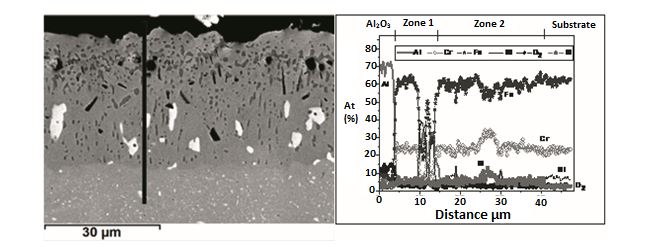
Figure 2 Cross section of Al-Si coating on stainless steels AISI 316 and oxidized in water vapor at 750° C during 1,000 hours.
In Figure 3 is observed the sweep image on contrast phase carried out by an AFM, in this figure is appreciably the topography of Al-Si/AISI 316 a cross section sample (oxidized at 750° C for 400 h). This figure shows a color-scheme changing from left (coating) to right (substrate). In addition, on the image can also be noted the voltage gradient, which is generated after Contrast phase sweep mode. It is appreciated on the substrate, the homogeneity of voltage peaks, as opposed to the coating zone, where the voltage signal decrease significantly. It is important to appreciate some voltages peak are higher than others on the substrate zone, and probably they are generated by aluminum inter-diffusion. Figure 3. Cross-section of Al-Si coating with TT, after to be oxidized in water vapor loop at 750° C for 400 hours
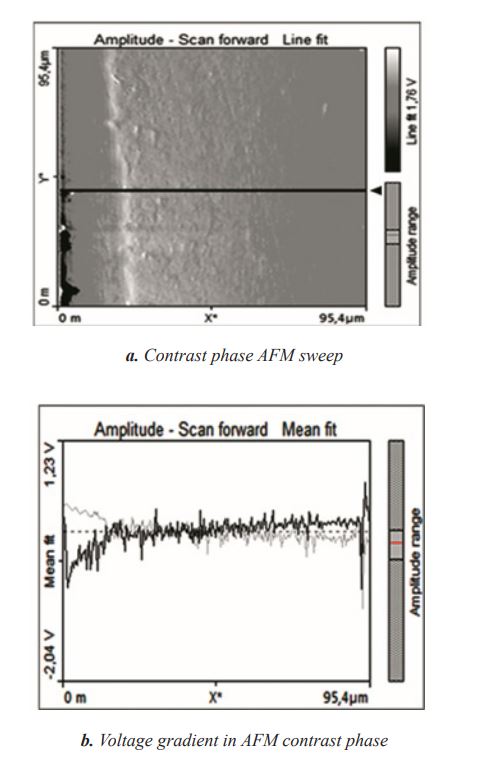
Figure 3 Cross-section of Al-Si coating with TT, after to be oxidized in water vapor loop at 750° C for 400 hours
The Figure 4 shows the topography and voltage amplitude by contrast mode AFM sweep. In this figure, the highest voltage peaks are light color and dark tones are the lowest. The C-S inter-phase shows the highest voltages peaks, decreasing into substrate. On the substrate, the voltage peaks are more homogeneity with an average values of 153.75 mV; reporting some higher peaks (307.5 mV) produced by aluminum inter-diffusion on the C-S interphase. This analysis gives visual information about the voltages behavior between sample and AFM cantilever during cross section sweep, notifying relevant information, which can be related with nano-hardness of sample 25,26.
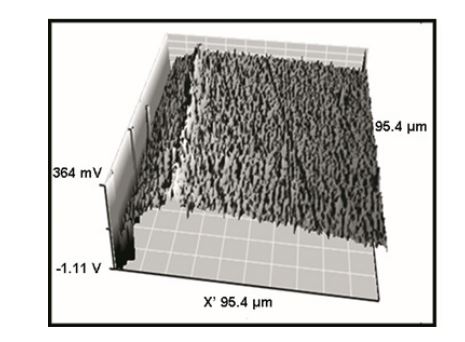
Figure 4 Differential voltage on cross-section of Al-Si coating with TT, after to be oxidized in a water vapor loop at 750° C for 400 hours
Finally, nano-indentation tests were carried out, which were in accordance with Vickers micro-hardness results, as well as with AFM voltage gradient. The nano-indentation tests reported variable hardness behavior (Figure 5), obtaining a maximum value of 11.4 GPa, on 23 µm on the surface sample (external sample side), whose length coincide with the AFM sweeps on the C-S interphase, where highest voltage peaks were reported. Advancing on coating into surface direction, hardness decreases along of 10 µm and increases of up to 8.5 GPa, and lastly start the final falling to the coating limit (5.5 GPa approximately), losing superficial homogeneity. Also, nano-indentation tests show hardness reduction as measures advances into the substrate, finally reaching a nano-hardness value between 6 and 7 GPa, which is greater 3 or 4 GPa than the typically ranges reported for the study steel 24,25. The above hardness reduction is almost gradual, but there is a fluctuation between 24 and 27 µm due to the formation of intermetallics by the aluminum diffusion into the substrate and the chromium-nickel diffusion into the coating; this phenomenon is appreciate in the AFM and SEM tests too.
Young’s modulus presents a similar behavior in comparison with nano-hardness, specifically on the C-S interphase, whose maximum value was 287 GPa (Figure 6). Advancing into the substrate, the modulus decreases reaching values up 250 GPa, a close value to the typically reported by other researchers for AISI 316 (200-240 GPa) 23,24; this difference is due to aluminum inter-diffusion after the thermal treatment. In respect to the coating zone, the Young’s modulus has a stable behavior, around 245 GPa and not present an important increasing in relation to the substrate. Previous works help to conclude that the aluminum coating deposited by CVD-FBR reported better results about mechanical properties, in comparison with aluminum-silicon coatings 26.
4. Conclusions
The obtained images by SEM and AFM showed good continuity between the substrate and the aluminum-silicon coating, due to there is not separation between them.
The Vickers micro-hardness and nano-hardness tests showed a hardness increase of coating in respect to the substrate, confirming a significant improve on the substrate hardness thanks to the Al-Si coating application under evaluation conditions; which is in accordance with the AFM studies. Even though, AFM technique does not give quantitative values of hardness changes on the sample surface, it gives qualitative values.
The Al-Si coating deposited by CVD-FBR can increase the resistance against water vapor on the substrate up to 100 times (improve of 25 %), front aluminum coating deposited by the same technique 17,26. That is the reason why the mechanical properties were evaluated, the mechanical tests reported significantly improvements and it projects a good coatings performance on service
The possible relation between voltage peaks reported by AFM sweeps (contrast phase mode) and nano-indentations results are showed. This possible relation drives the future studies to focus in to find their bond.













